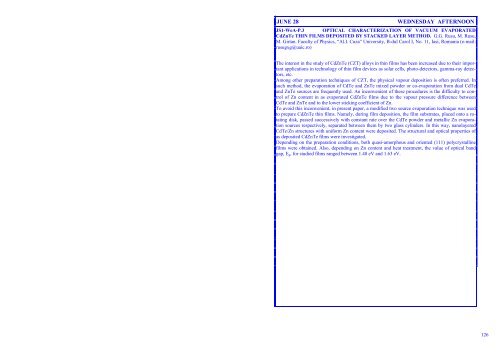Wüest M. 51 Wykes M. 82 Yamaguchi M. 17 Ybarra G. 129 Yubero F ...
Wüest M. 51 Wykes M. 82 Yamaguchi M. 17 Ybarra G. 129 Yubero F ...
Wüest M. 51 Wykes M. 82 Yamaguchi M. 17 Ybarra G. 129 Yubero F ...
You also want an ePaper? Increase the reach of your titles
YUMPU automatically turns print PDFs into web optimized ePapers that Google loves.
JUNE 28 WEDNESDAY AFTERNOON<br />
JS1-WeA-P.3 OPTICAL CHARACTERIZATION OF VACUUM EVAPORATED<br />
CdZnTe THIN FILMS DEPOSITED BY STACKED LAYER METHOD. G.G. Rusu, M. Rusu,<br />
M. Girtan. Faculty of Physics, “Al.I. Cuza” University, B-dul Carol I, No. 11, Iasi, Romania (e-mail:<br />
rusugxg@uaic.ro)<br />
The interest in the study of CdZnTe (CZT) alloys in thin films has been increased due to their important<br />
applications in technology of thin film devices as solar cells, photo-detectors, gamma-ray detectors,<br />
etc.<br />
Among other preparation techniques of CZT, the physical vapour deposition is often preferred. In<br />
such method, the evaporation of CdTe and ZnTe mixed powder or co-evaporation from dual CdTe<br />
and ZnTe sources are frequently used. An inconvenient of these procedures is the difficulty to control<br />
of Zn content in as evaporated CdZnTe films due to the vapour pressure difference between<br />
CdTe and ZnTe and to the lower sticking coefficient of Zn.<br />
To avoid this inconvenient, in present paper, a modified two source evaporation technique was used<br />
to prepare CdZnTe thin films. Namely, during film deposition, the film substrates, placed onto a rotating<br />
disk, passed successively with constant rate over the CdTe powder and metallic Zn evaporation<br />
sources respectively, separated between them by two glass cylinders. In this way, nanolayered<br />
CdTe/Zn structures with uniform Zn content were deposited. The structural and optical properties of<br />
as deposited CdZnTe films were investigated.<br />
Depending on the preparation conditions, both quasi-amorphous and oriented (111) polycrystalline<br />
films were obtained. Also, depending on Zn content and heat treatment, the value of optical band<br />
gap, E g , for studied films ranged between 1.48 eV and 1.63 eV.<br />
126
















